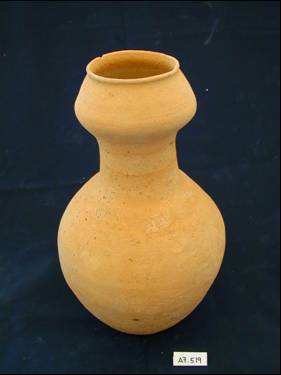Back to top: Major finds
Overview
|
Excavations in the palace have yielded rooms and courtyards with large numbers of ceramics in situ. From the permanent installations within rooms and courtyards and the large quantity of sherds and whole vessels excavated in them we have been able to determine the function of several of these spaces. Generally long term storage is done in large shouldered jars with flat or convex bases (A15.253, A15.246). Since they had a narrow neck they may have been used for storing either liquids or solids. Large wide mouth jars were convenient for scooping out solids and are often decorated with rope decoration (A15.244). Short term storage vessels are smaller and have restricted entry because the contents (either liquid or solid) can easily be poured out. They usually have a rounded base (A15.311) and may have occasionally been placed in a stand as we do find a few in the ceramic record. While there are few large serving trays found at the site, we do have a large number of medium and small bowls (A15.304) that could have been used for the serving of food. Often the bowls are quickly made and cut off the wheel leaving string marks on the base. Conical cups predominate in the palace strata; most were thrown quickly and also cut from the wheel with a string (A15.305). Experiments we have conducted show that if the clay is prepared ahead, a single potter can produce 500 conical cups a day. One of these store-rooms of the formal wing of the palace, dating to Phase 3, contained all of the vessels just discussed, so we are certain that the ceramic assemblage was in use during the same period. Some ceramic vessels are rare in the excavations and may have been imported or only used in a ritual context. Two such vessels come from the strata near the entrance of the ā. They have a short neck, globular body and round base. What makes them unusual are the two vertical handles with horizontal holes pierced in them, attached to the widest part of the body (A14.122). Even more striking is the fact that dark brown paint is applied to the body and base and then the firing was such that a darker horizontal line appeared between the lower part of the vessel and the unfired bright orange neck and rim. This type of paint and firing have only been found previously in shallow bowls. |


|
Back to top: Major finds
Visual walk-through of selected Urkesh ceramics
Back to top: Major finds
Early third millennium




Back to top: Major finds
Second half of the third millennium





Back to top: Major finds
First half of second millennium





For a detailed study see the digital book Urkesh Ceramic Typology.